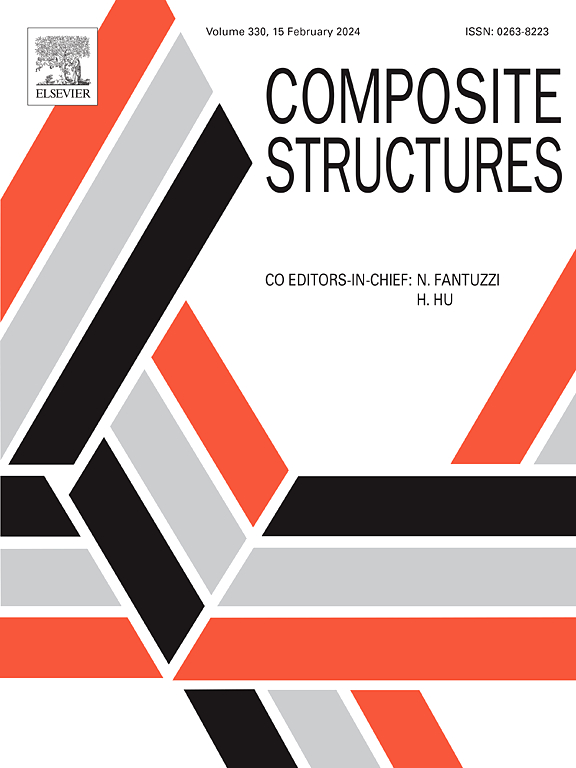基于有限元子建模技术的风力涡轮机叶片后缘疲劳分析和可靠性建模
IF 6.3
2区 材料科学
Q1 MATERIALS SCIENCE, COMPOSITES
引用次数: 0
摘要
风力涡轮机叶片在风力涡轮机系统中起着至关重要的作用,其后缘承受着巨大的机械负荷。在运行周期中,粘合的复合材料后缘可能会断裂、脱层或弯曲,给风力涡轮机系统带来安全风险。由于全尺寸结构试验在成本和时间上的挑战,有限元模拟通常用于评估叶片的疲劳性能,但目前的方法主要关注叶片的整体疲劳特性,而忽略了专门的分析。本文介绍了一种有限元子建模方法,通过分析风力涡轮机叶片后缘的疲劳和可靠性来填补这一研究空白。具体而言,本文提出了一种有限元子建模方法,用于分析风力涡轮机叶片的局部疲劳失效。通过对传统复合材料粘接试样进行疲劳测试,对该方法进行了验证。随后,对拖曳边缘进行了失效分析和寿命预测,以研究其疲劳行为,并探讨了子建模技术对分析结果的影响。此外,考虑到材料和尺寸的不确定性,还为后缘建立了疲劳可靠性模型。结果表明,这种方法有效地克服了整体叶片有限元分析的局限性,实现了对后缘的局部疲劳分析,为改进风力涡轮机叶片的优化设计提供了宝贵的见解。本文章由计算机程序翻译,如有差异,请以英文原文为准。
Finite element submodeling technique-based fatigue analysis and reliability modeling of wind turbine blade trailing edge
Wind turbine blades play a critical role in wind turbine systems, with the trailing edge bearing significant mechanical loads. During operational cycles, the adhesively bonded composite trailing edge may fracture, delaminate, or buckle, posing a safety risk for wind turbine systems. While finite element simulation is commonly used to evaluate blade fatigue performance due to the challenges associated with full-scale structural tests in terms of costs and time, current methodologies mainly focus on the overall fatigue characteristics of blades, neglecting specialized analyses. A finite element submodeling approach is presented here to address this research gap by analyzing wind turbine blade trailing edges for fatigue and reliability. Specifically, a finite element submodeling method is proposed to analyze local fatigue failures of wind turbine blades. This approach is validated through fatigue testing on conventional composite bonded specimens. Subsequently, failure analyses and life predictions are conducted on the trailing edges to investigate their fatigue behavior, followed by an exploration of the impact of submodeling techniques on the analysis results. Furthermore, considering material and dimensional uncertainties, a fatigue reliability model for trailing edges is developed. The results demonstrate that this approach effectively overcomes the limitations of overall blade finite element analysis by enabling localized fatigue analysis of the trailing edge, providing valuable insights for improving wind turbine blade design optimization.
求助全文
通过发布文献求助,成功后即可免费获取论文全文。
去求助
来源期刊

Composite Structures
工程技术-材料科学:复合
CiteScore
12.00
自引率
12.70%
发文量
1246
审稿时长
78 days
期刊介绍:
The past few decades have seen outstanding advances in the use of composite materials in structural applications. There can be little doubt that, within engineering circles, composites have revolutionised traditional design concepts and made possible an unparalleled range of new and exciting possibilities as viable materials for construction. Composite Structures, an International Journal, disseminates knowledge between users, manufacturers, designers and researchers involved in structures or structural components manufactured using composite materials.
The journal publishes papers which contribute to knowledge in the use of composite materials in engineering structures. Papers deal with design, research and development studies, experimental investigations, theoretical analysis and fabrication techniques relevant to the application of composites in load-bearing components for assemblies, ranging from individual components such as plates and shells to complete composite structures.
 求助内容:
求助内容: 应助结果提醒方式:
应助结果提醒方式:


